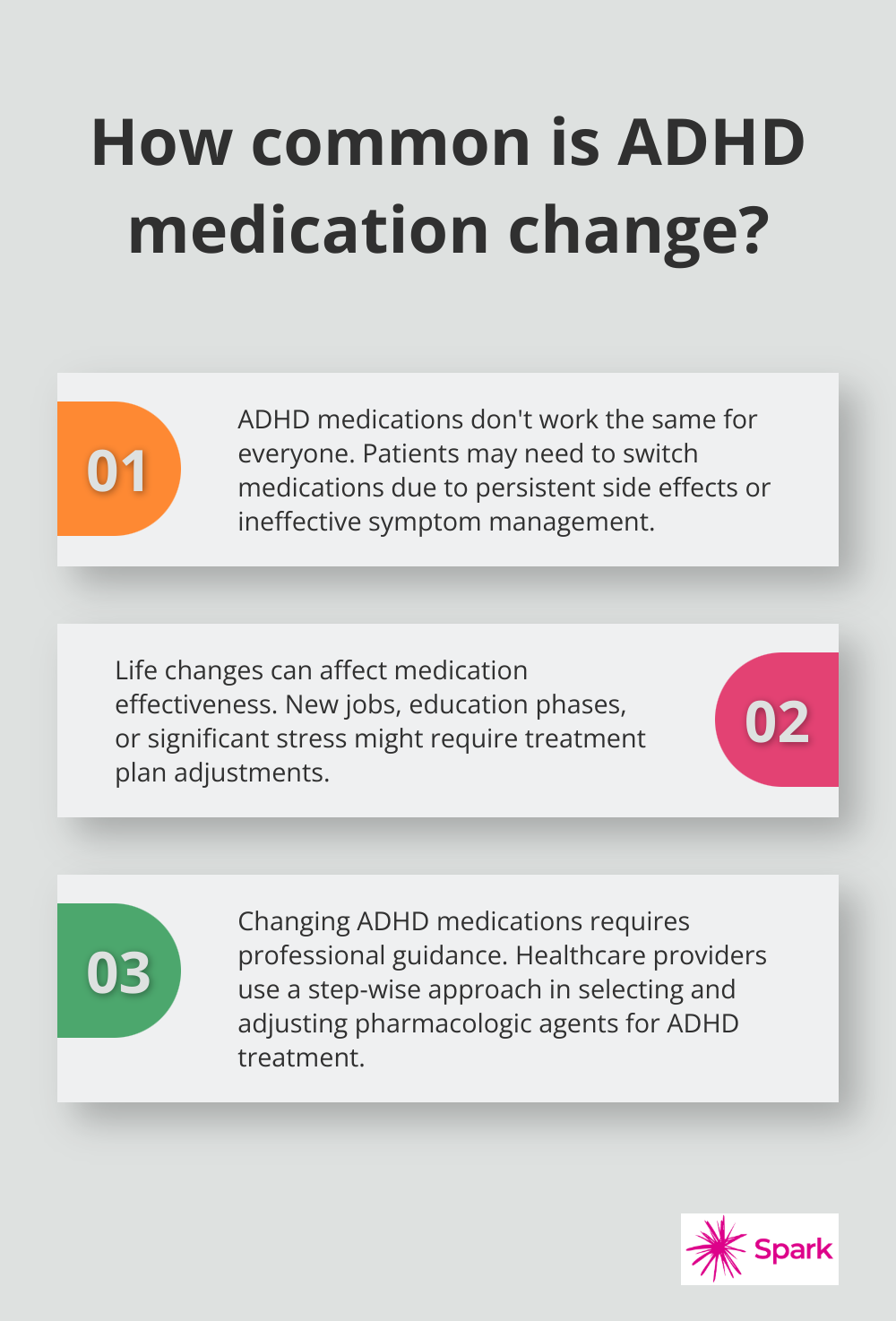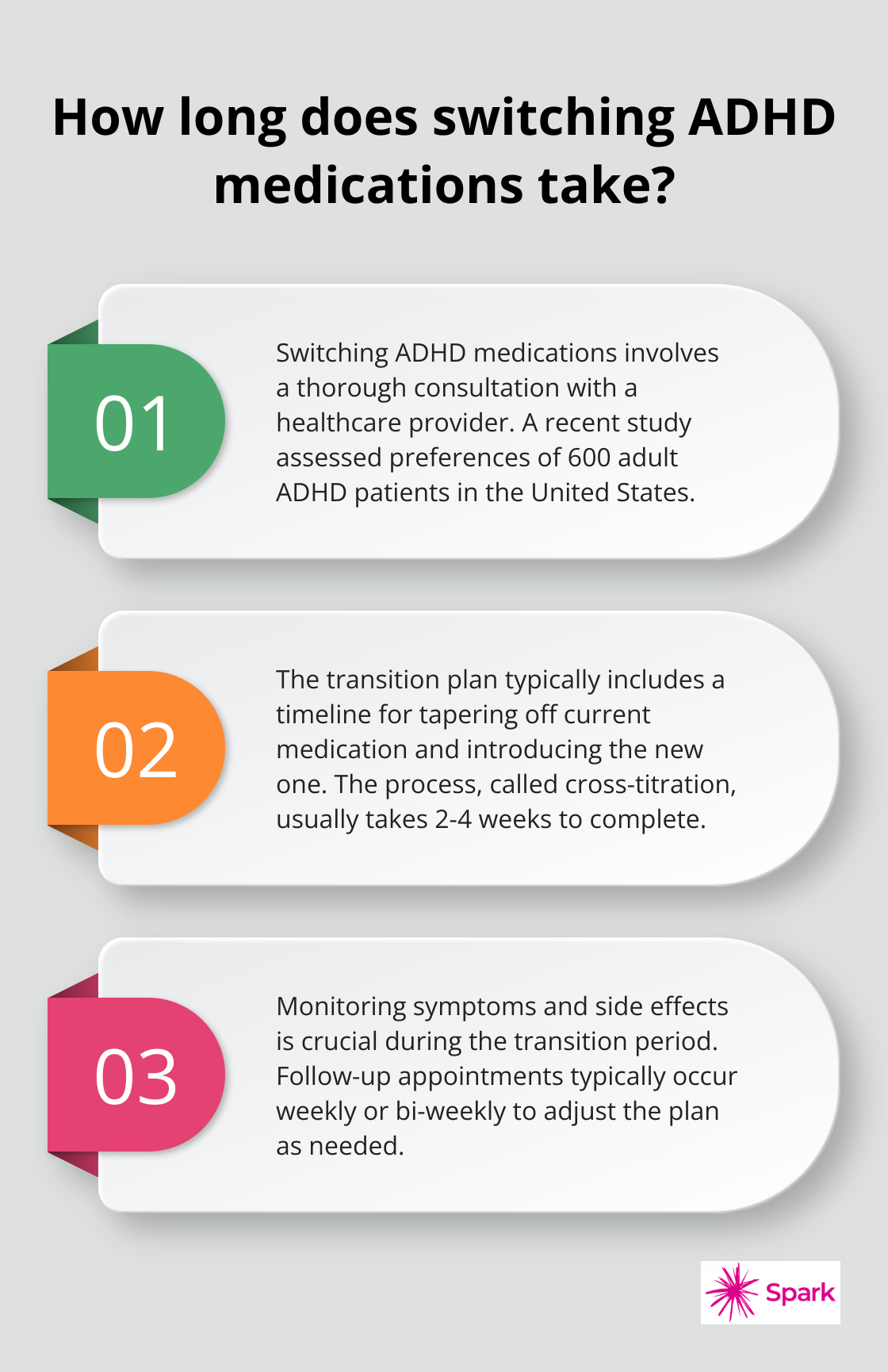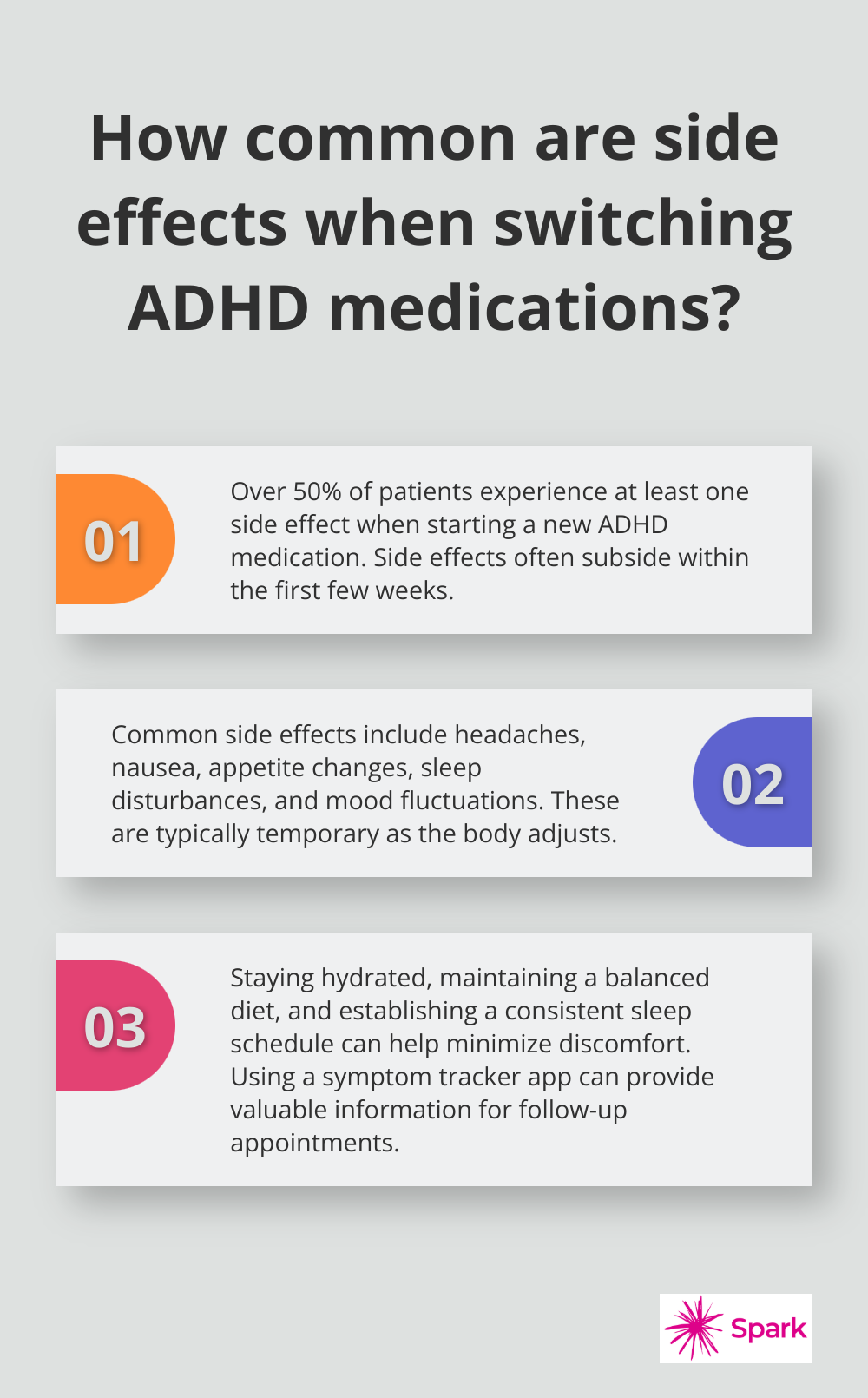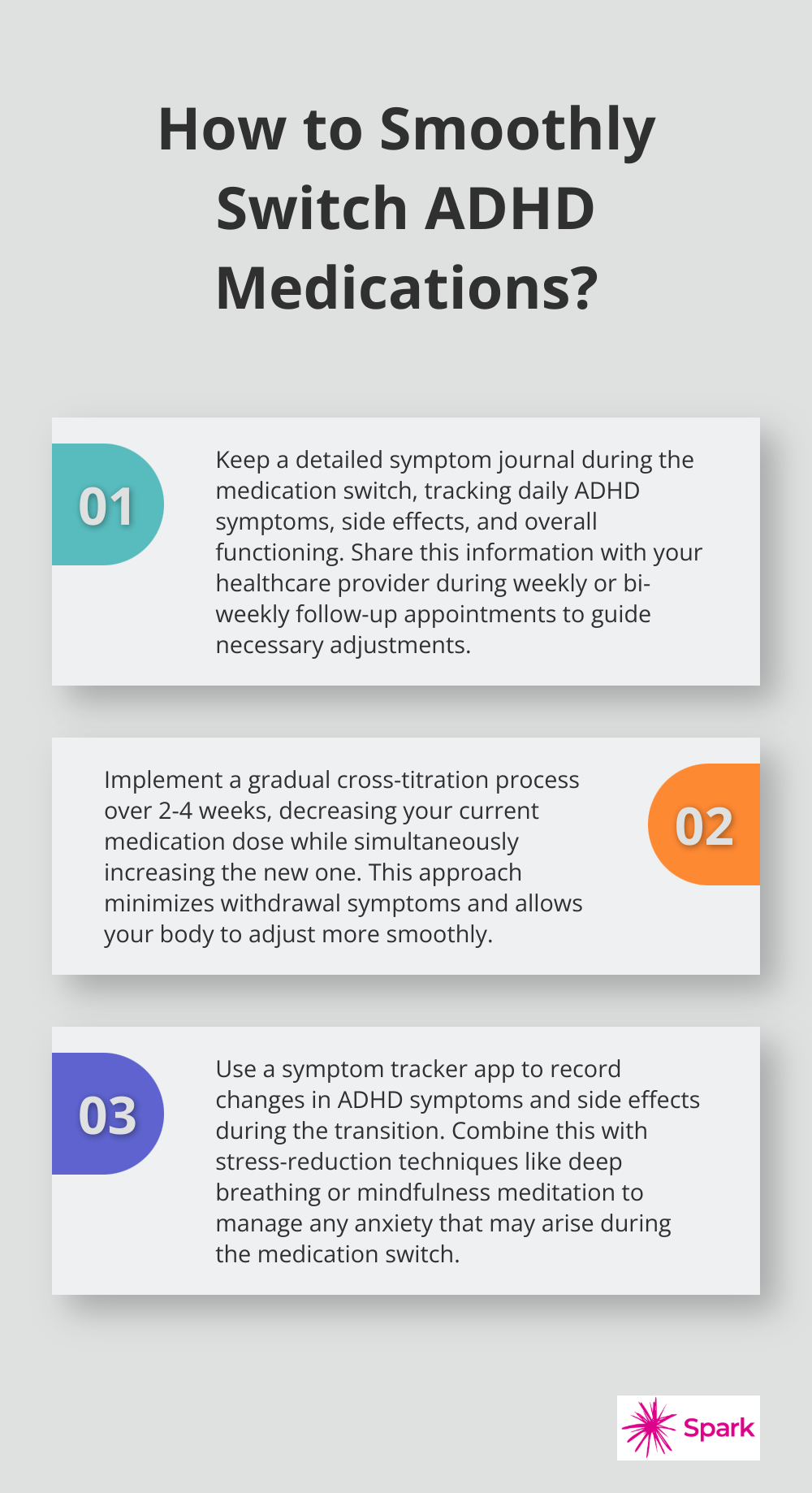Switching ADHD medications can be a daunting process, but it’s often necessary for optimal treatment. At Spark Mental Health, we understand the challenges and concerns that come with changing your medication regimen.
This guide will walk you through how to switch ADHD medications safely and effectively, ensuring you have the knowledge and tools to navigate this transition with confidence. We’ll cover everything from recognizing when a change is needed to managing potential side effects during the adjustment period.
Why Change Your ADHD Medication?
Recognizing the Need for Change
ADHD medications don’t always work the same for everyone. You might need to switch your medication if you experience persistent side effects or if your symptoms don’t improve as expected. A study aimed to comprehensively review factors involved in prescribing and medication use in individuals diagnosed with ADHD.

Monitor your daily functioning closely. If you still struggle with focus, impulsivity, or hyperactivity despite taking your medication as prescribed, consult your healthcare provider. Start a symptom journal to track your experiences and share this information during your appointments.
Life Changes and Medication Effectiveness
Your life circumstances can affect how your ADHD medication works. A new job, a different phase of education, or significant stress might require adjustments to your treatment plan. The American Academy of Pediatrics offers guidance on the evaluation, presentation, and management of ADHD for primary care pediatricians.
The Importance of Professional Guidance
Changing ADHD medications requires careful consideration. Work closely with a healthcare professional who specializes in ADHD treatment. They can help you weigh potential benefits against risks and create a tailored transition plan.
Your provider might suggest a gradual tapering off of your current medication while introducing a new one (a process known as cross-titration). Medical practitioners can follow a step-wise approach in the selection and adjustment of pharmacologic agents to treat ADHD, while working closely with families.
Preparing for the Transition
During the medication switch, prepare for a temporary increase in ADHD symptoms. This is normal and usually subsides as your body adjusts to the new medication. However, contact your healthcare provider immediately if you experience severe side effects or a significant worsening of symptoms.
Finding the right ADHD medication often involves some trial and error. It’s not uncommon to try several medications before finding the one that works best for you. Stay patient and maintain open communication with your healthcare team throughout the process.
As we move forward, let’s explore the specific steps you can take to ensure a safe and effective transition between ADHD medications. Additionally, consider incorporating mental health improvement activities to support your overall well-being during this transition.
How to Switch ADHD Medications Step by Step
Initiate a Thorough Consultation
The first step involves scheduling an in-depth consultation with your healthcare provider. During this appointment, prepare to discuss your current medication’s effectiveness, any side effects you experience, and your treatment goals. Bring your symptom journal to provide concrete examples of how your current medication works (or doesn’t work).

A recent study assessed adult patient preferences for attention-deficit/hyperactivity disorder (ADHD) treatments in a sample of 600 patients in the United States. Your input plays a vital role in determining the best course of action.
Develop a Personalized Transition Plan
Your healthcare provider will create a tailored transition plan based on your consultation. This plan typically includes:
- A timeline for tapering off your current medication
- The new medication and starting dosage
- A schedule for gradually increasing the new medication
- Follow-up appointments to monitor progress
The American Academy of Child and Adolescent Psychiatry recommends that transition plans should be individualized, taking into account factors such as the patient’s medical history, lifestyle, and specific ADHD symptoms.
Implement the Transition
The actual switch usually involves a process called cross-titration. This means you gradually decrease your current medication while simultaneously introducing the new one. The exact timeline can vary, but it often takes 2-4 weeks.
For example, if you switch from one medication to another, your doctor might reduce your current dose while increasing the new medication dose. This approach minimizes withdrawal symptoms and allows your body to adjust gradually.
Monitor and Adjust
During the transition period, you must monitor your symptoms and any side effects closely. Use a daily tracker to record:
- ADHD symptom severity
- Side effects (e.g., changes in appetite, sleep patterns, mood)
- Overall functioning in work or school
Share this information with your healthcare provider during follow-up appointments. These typically occur weekly or bi-weekly during the transition period.
Finding the right medication and dosage often requires some trial and error. If you experience severe side effects or a significant worsening of symptoms, contact your healthcare provider immediately. They may need to adjust your transition plan or consider alternative medications.
As we move forward, it’s important to understand how to manage potential side effects and set realistic expectations during this transition period. Let’s explore these aspects in the next section to ensure you’re fully prepared for your medication switch.
What to Expect When Switching ADHD Medications
Common Side Effects During Transition
Switching ADHD medications can cause temporary side effects as your body adjusts. These may include headaches, nausea, appetite changes, sleep disturbances, and mood fluctuations. A study found that more than half of the patients experienced at least one side effect when starting a new ADHD medication.

These side effects often subside within the first few weeks of starting a new medication. However, if they persist or worsen, contact your healthcare provider promptly.
Coping Strategies for a Smoother Transition
To minimize discomfort during the medication switch, try these practical strategies:
- Stay hydrated and maintain a balanced diet to help your body process the medication more effectively.
- Establish a consistent sleep schedule to support your body’s adjustment to the new medication.
- Use a symptom tracker app to record changes in your ADHD symptoms or side effects. This information will prove valuable during follow-up appointments with your healthcare provider.
- Practice stress-reduction techniques (such as deep breathing exercises or mindfulness meditation). These methods can help manage anxiety that may arise during medication transitions.
Setting Realistic Expectations
Finding the right ADHD medication and dosage often takes time. It can take several weeks to determine if a new medication works effectively.
During this period, you might experience fluctuations in your ADHD symptoms. Some days may feel better than others. This doesn’t necessarily mean the new medication isn’t working. Give yourself time during this adjustment period and maintain open communication with your healthcare provider.
When to Seek Immediate Medical Attention
While most side effects are mild and temporary, certain symptoms require immediate medical attention. Contact your healthcare provider or seek emergency care if you experience:
- Severe allergic reactions (difficulty breathing, swelling of the face or throat)
- Chest pain or irregular heartbeat
- Extreme mood changes or suicidal thoughts
- Seizures or loss of consciousness
The FDA emphasizes the importance of monitoring for these rare but serious side effects, especially in the first few weeks of starting a new medication.
Your healthcare provider is your partner in this process. Don’t hesitate to reach out with any concerns or questions during your medication transition.
Final Thoughts
Switching ADHD medications requires careful planning and professional guidance. You must communicate openly with your healthcare provider throughout the process. Track your symptoms, side effects, and overall well-being using a symptom tracker or journal to help your provider make informed decisions about your treatment plan.

At Spark Mental Health, we offer personalized telepsychiatry services for conditions like ADHD. Our team provides flexible online scheduling and individualized care plans. If you need support on how to switch ADHD medications or manage your symptoms, visit our website to learn more about our services.
Finding the right ADHD medication and dosage takes time and patience. Stay committed to your treatment plan and maintain open communication with your healthcare provider. With the right approach and support, you can successfully navigate the medication switching process and improve your symptom management.






